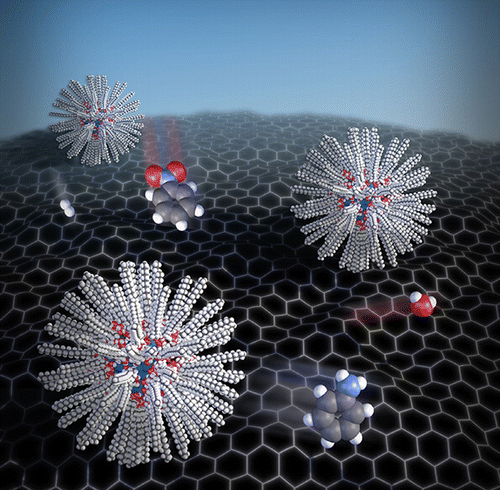当前位置:
X-MOL 学术
›
ACS Catal.
›
论文详情
Our official English website, www.x-mol.net, welcomes your feedback! (Note: you will need to create a separate account there.)
Structure and Reactivity of Supported Hybrid Platinum Nanoparticles for the Flow Hydrogenation of Functionalized Nitroaromatics
ACS Catalysis ( IF 11.3 ) Pub Date : 2015-05-22 00:00:00 , DOI: 10.1021/acscatal.5b00885 Gianvito Vilé 1 , Neyvis Almora-Barrios 2 , Núria López 2 , Javier Pérez-Ramírez 1
ACS Catalysis ( IF 11.3 ) Pub Date : 2015-05-22 00:00:00 , DOI: 10.1021/acscatal.5b00885 Gianvito Vilé 1 , Neyvis Almora-Barrios 2 , Núria López 2 , Javier Pérez-Ramírez 1
Affiliation

|
This contribution targets the first comprehensive understanding of the next-generation catalyst for nitroarene hydrogenation, featuring ligand-capped 2 nm platinum nanoparticles (Pt-HHDMA, HHDMA: hexadecyl(2-hydroxyethyl)dimethylammonium dihydrogen phosphate) deposited on carbon. Fundamental questions related to the structure, properties, and mechanistic fingerprints of the metal–organic interphase of the hybrid system were addressed through a battery of advanced characterization methods and theoretical calculations. Catalytic tests conducted in a flow reactor at variable temperature and pressure revealed the superior activity of Pt-HHDMA in comparison with the archetypal and industrially relevant Lindlar-type Pt–Pb/CaCO3, with outstanding chemoselectivity and leaching resistance. The analysis of the reaction mechanism by Density Functional Theory, which was never addressed systematically, showed that the benefits of the ligand-modified catalyst arise from the facilitated H2 activation and weak nitroarene adsorption on the HHDMA-modified surface. At the same time, the ligand isolates the platinum ensemble, reducing the possibility of unselective routes by controlling the adsorption geometry and extent of the reactant and product intermediates. These results substantially enrich the mechanistic understanding of HHDMA-modified Pt catalyst and are of fundamental relevance for future improvements of this hybrid catalyst and for extrapolating this technology to other challenging reactions.
中文翻译:

功能化硝基芳烃流加氢负载杂化铂纳米粒子的结构和反应性
该贡献的目标是对下一代硝基芳烃加氢催化剂的首次全面了解,其特征是沉积在碳上的配体封端的2 nm铂纳米颗粒(Pt-HHDMA,HHDMA:十六烷基(2-羟乙基)二甲基磷酸二氢铵)。通过一系列先进的表征方法和理论计算,解决了与混合系统的金属-有机界面相的结构,性质和机械指纹有关的基本问题。在流动反应器中在可变温度和压力下进行的催化测试表明,与原型和工业上相关的Lindlar型Pt-Pb / CaCO 3相比,Pt-HHDMA的活性更高。,具有出色的化学选择性和耐浸出性。通过密度泛函理论对反应机理的分析从未得到系统地解决,该分析表明,配体修饰的催化剂的优点来自于HHDMA修饰的表面上促进的H 2活化和弱的硝基芳烃吸附。同时,配体分离了铂系化合物,通过控制反应物和产物中间体的吸附几何形状和程度降低了非选择性路线的可能性。这些结果大大丰富了对HHDMA修饰的Pt催化剂的机械理解,对于该杂化催化剂的未来改进以及将该技术推广到其他具有挑战性的反应具有根本意义。
更新日期:2015-05-22
中文翻译:

功能化硝基芳烃流加氢负载杂化铂纳米粒子的结构和反应性
该贡献的目标是对下一代硝基芳烃加氢催化剂的首次全面了解,其特征是沉积在碳上的配体封端的2 nm铂纳米颗粒(Pt-HHDMA,HHDMA:十六烷基(2-羟乙基)二甲基磷酸二氢铵)。通过一系列先进的表征方法和理论计算,解决了与混合系统的金属-有机界面相的结构,性质和机械指纹有关的基本问题。在流动反应器中在可变温度和压力下进行的催化测试表明,与原型和工业上相关的Lindlar型Pt-Pb / CaCO 3相比,Pt-HHDMA的活性更高。,具有出色的化学选择性和耐浸出性。通过密度泛函理论对反应机理的分析从未得到系统地解决,该分析表明,配体修饰的催化剂的优点来自于HHDMA修饰的表面上促进的H 2活化和弱的硝基芳烃吸附。同时,配体分离了铂系化合物,通过控制反应物和产物中间体的吸附几何形状和程度降低了非选择性路线的可能性。这些结果大大丰富了对HHDMA修饰的Pt催化剂的机械理解,对于该杂化催化剂的未来改进以及将该技术推广到其他具有挑战性的反应具有根本意义。












































 京公网安备 11010802027423号
京公网安备 11010802027423号